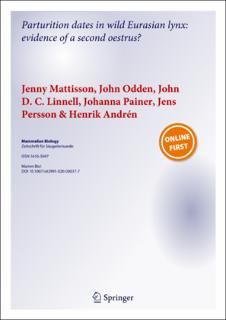| dc.contributor.author | Mattisson, Jenny | |
| dc.contributor.author | Odden, John | |
| dc.contributor.author | Linnell, John Durrus | |
| dc.contributor.author | Painer, Johanna | |
| dc.contributor.author | Persson, Jens | |
| dc.contributor.author | Andrén, Henrik | |
| dc.coverage.spatial | Scandinavia, Skandinavia, Skandinavien | en_US |
| dc.date.accessioned | 2020-06-26T09:52:58Z | |
| dc.date.available | 2020-06-26T09:52:58Z | |
| dc.date.created | 2020-06-10T14:52:41Z | |
| dc.date.issued | 2020 | |
| dc.identifier.issn | 1616-5047 | |
| dc.identifier.uri | https://hdl.handle.net/11250/2659634 | |
| dc.description.abstract | Understanding reproductive physiology of a species is important to assess their potential to respond to environmental variation and perturbation of their social system during the mating or pre-mating seasons. We report 175 parturition dates from wild Eurasian lynx (Lynx lynx) in Scandinavia. Most lynx birth dates were highly synchronised around a mean of 30th May (SD = 9 days) with 173 of the 175 births ranging from May 2nd to June 30th. We detected two very late births on July 29th and August 15th in the absence of any indication that the females had given birth and lost a litter earlier in the year. We propose that these represent evidence of a second oestrus which is highly unusual in lynx because of their unique reproductive physiology. The rarity of these late season births has implications for lynx demography and social organisation. Lynx lynx · Reproduction · Parturition date · Conservation | en_US |
| dc.language.iso | eng | en_US |
| dc.rights | Navngivelse 4.0 Internasjonal | * |
| dc.rights.uri | http://creativecommons.org/licenses/by/4.0/deed.no | * |
| dc.subject | Lynx lynx | en_US |
| dc.subject | Reproduction | en_US |
| dc.subject | Parturition date | en_US |
| dc.subject | Conservation | en_US |
| dc.title | Parturition dates in wild Eurasian lynx: evidence of a second oestrus? | en_US |
| dc.type | Peer reviewed | en_US |
| dc.type | Journal article | en_US |
| dc.description.version | publishedVersion | en_US |
| dc.rights.holder | © The Author(s) 2020 | en_US |
| dc.subject.nsi | VDP::Zoologiske og botaniske fag: 480 | en_US |
| dc.subject.nsi | VDP::Zoology and botany: 480 | en_US |
| dc.source.journal | Mammalian Biology | en_US |
| dc.identifier.doi | 10.1007/s42991-020-00037-7 | |
| dc.identifier.cristin | 1814851 | |
| dc.relation.project | Norges forskningsråd: 212919 | en_US |
| dc.relation.project | Norges forskningsråd: 183176 | en_US |
| dc.relation.project | Norges forskningsråd: 165814 | en_US |
| dc.relation.project | Andre: Swedish Environmental Protection Agency | en_US |
| dc.relation.project | Norges forskningsråd: 251112 | en_US |
| dc.relation.project | Andre: Swedish Research Council for Environment | en_US |
| dc.relation.project | Andre: Norwegian Environment Agency | en_US |
| dc.relation.project | Andre: Agricultural Sciences and Spatial Planning (FORMAS) | en_US |
| cristin.ispublished | true | |
| cristin.fulltext | original | |
| cristin.qualitycode | 1 | |

